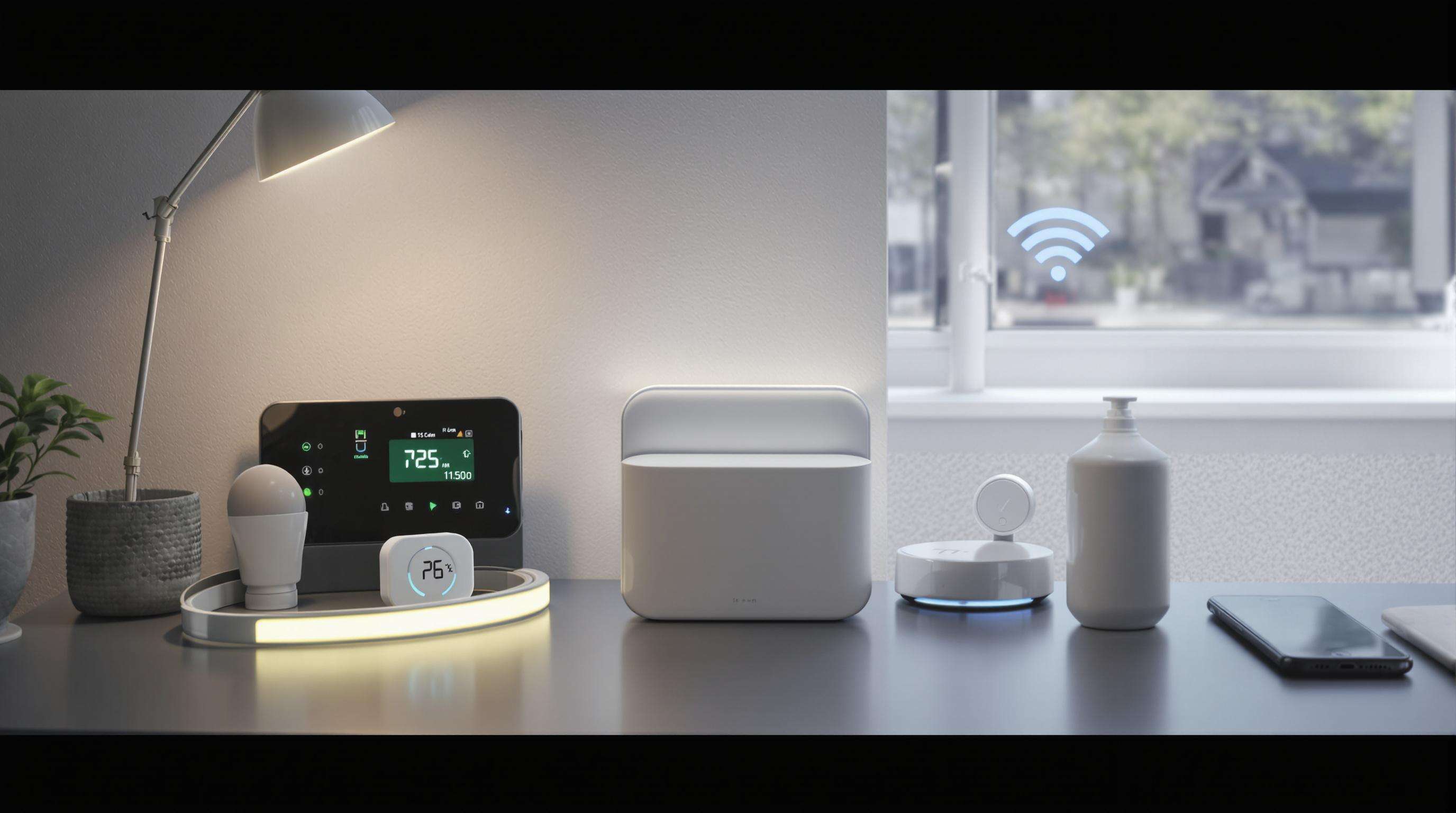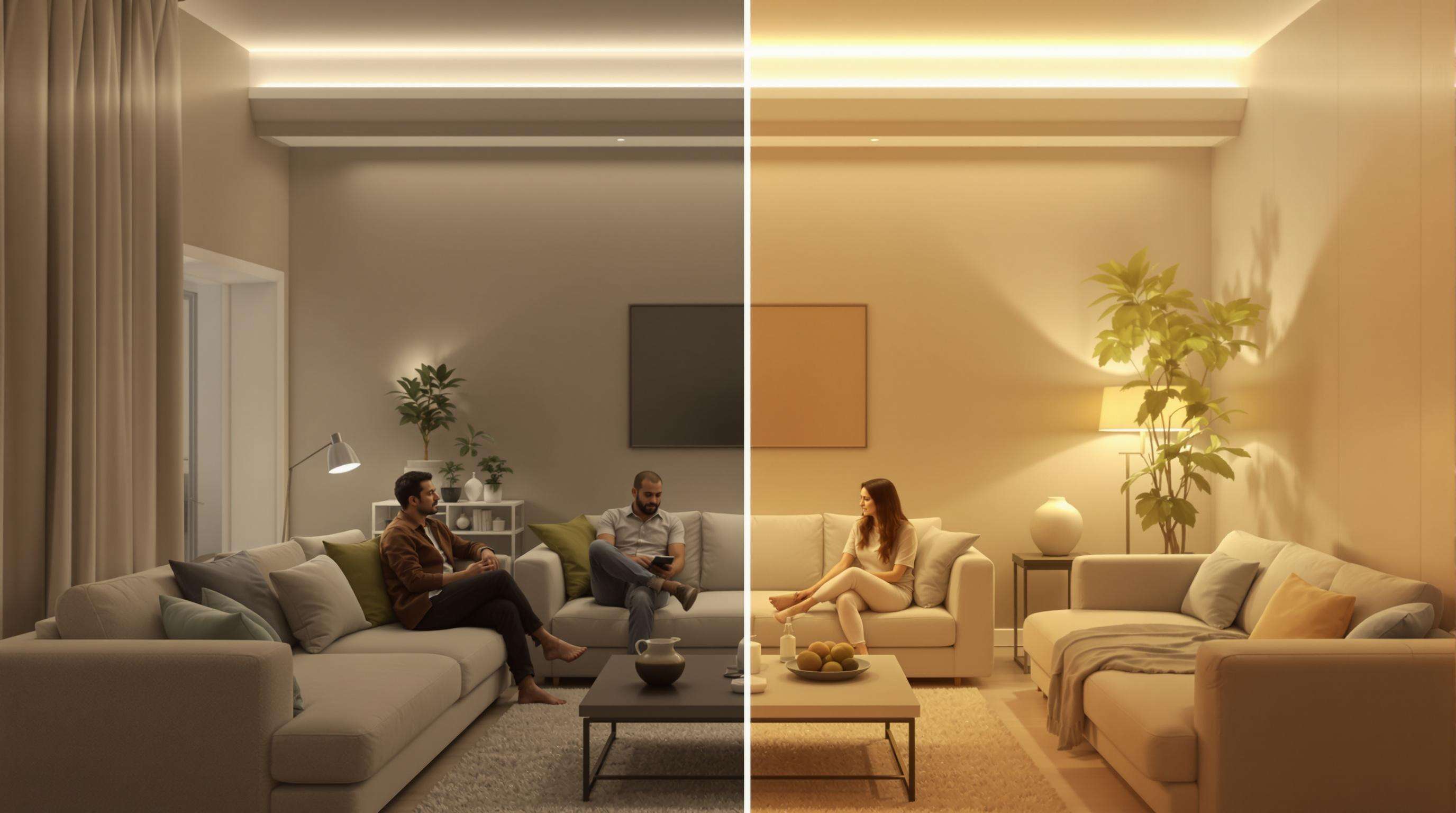Aplikasi Inovatif Lampu Strip LED dalam Rumah Pintar
Bagaimana lampu silang LED berpaparan IoT meningkatkan sambungan rumah pintar
Lampu silang LED berpaparan IoT kini bukan lagi sekadar pencahayaan satu hala yang biasa, penambahan cip wayarles dan sensor membolehkannya berfungsi dalam dunia pintar yang lebih besar dan lebih cerdik. Silang ini boleh mengesan suhu bilik sambil menyambungkan termostat, sistem keselamatan, dan peralatan hiburan. Menurut satu kajian tentang ‘penerimaan rumah pintar pada 2023’, 68% pemilik rumah pintar memilih sistem pencahayaan yang boleh diotomatis tanpa mengira peranti.
Kawalan Wi-Fi dan Bluetooth untuk penyegerakan tanpa gangguan di antara peranti
Jalur LED berasaskan Wi-Fi hanya boleh dikawal dari jauh kerana ia bergantung kepada awan dan kebanyakannya tidak berfungsi tanpa internet, sebaliknya, berasaskan Bluetooth wujud pada rangkaian tempatan dan boleh diuruskan oleh perkhidmatan. Hanya jalur dwi-protokol yang menawarkan kedua-dua ciri ini, memberikan sehingga 40% kurang masalah sambungan berbanding sistem protokol tunggal (Laporan Penanda Aras Kesambungan 2024). Ini bermakna muzik yang lebih lancar dengan kurang ouch sama ada anda berada dalam zon Wi-Fi yang kuat itu atau zon Wi-Fi yang tidak begitu kuat untuk membantu muzik anda mengekalkan muzik anda.
Keserasian dengan Google Home, Apple HomeKit, dan Samsung SmartThings
Platform rumah pintar terkemuka menggambarkan pencahayaan sebagai komponen utama di bawah arahan berkongsi seperti "Selamat Malam" atau "Mod Filem." Samsung SmartThings membolehkan kawalan yang lebih halus melalui Editor Rutin Aplikasinya, membolehkan pengguna menentukan peralihan kecerahan tertentu berdasarkan waktu matahari terbenam atau pencetus keselamatan. Interoperabiliti ini memberi kepuasan 55% kepada pengguna berbilang platform (Kajian Ekosistem Rumah Pintar 2024).
Peranan pusat kawalan pintar dan protokol (Zigbee, Matter) dalam integrasi yang boleh dipercayai

Pusat kawalan pintar seperti Philips Hue Bridge menyelesaikan konflik protokol dengan menterjemahkan antara Wi-Fi, Zigbee, dan standard berkaitan. Protokol Matter mengurangkan latensi sebanyak 30% dalam persekitaran campuran pengeluar, manakala rangkaian Zigbee memastikan sambungan kekal dalam pemasangan besar.
Kawalan Suara dan Aplikasi untuk Pengalaman Pencahayaan Tanpa Tangan dan Peribadi
Menggunakan Alexa dan Google Assistant untuk Pencahayaan Jalur LED Aktif-Suara
Pita LED yang membolehkan suara bertindak balas kepada arahan semula jadi seperti „tetapkan kecerahan bilik tamu kepada 50%“ atau „aktifkan mod matahari terbenam,“ menyokong keperluan isi rumah yang perlu melakukan pelbagai tugas dan pengguna dengan kekangan mobiliti. Sistem yang lebih maju turut menyesuaikan kecerahan secara beransur-ansur semasa rutin harian untuk sejajar dengan ritma sedia ada.
Menyesuaikan Warna, Kecerahan, dan Pemandangan melalui Aplikasi Telefon Pintar
Aplikasi telefon pintar membolehkan:
- Pemilihan daripada berjuta-juta warna RGB
- Pelarasan suhu cahaya putih (2700K–6500K)
- Pemandangan tersuai seperti „Malam Filem“ dengan pengaktifan satu sentuhan
Algoritma ritma sedia ada mengautomasikan perubahan kecerahan dan suhu warna untuk ritma harian yang optimum.
Mengautomasikan Jadual dan Rutin Pencahayaan untuk Keselesaan dan Kecekapan
Peraturan automatik mengoptimumkan penggunaan tenaga:
| Jenis Jadual | Contoh Kes Penggunaan | Kesan Tenaga |
|---|---|---|
| Berasaskan Masa | Lampu menyala perlahan pada 6:30 pagi pada hari bekerja | Mengurangkan kejutan kuasa pada waktu pagi |
| Dicetuskan Mengikut Aktiviti | Lampu di bawah kabinet menjadi lebih terang semasa memasak | Mengelakkan penggunaan berlebihan |
Sistem ini boleh mengurangkan penggunaan tenaga pencahayaan sehingga 40%.
Geofencing dan Pengesanan Kehadiran: Lampu Yang Menyesuaikan Diri Dengan Lokasi Anda
Geofencing mencetuskan perubahan pencahayaan berdasarkan lokasi pengguna:
- Geofence masuk : Cahaya beranda diaktifkan semasa tiba
- Pengesanan pada tahap bilik : Cahaya almari menjadi terang dengan pergerakan
- Rutin keluar : Cahaya padam selepas keluar dari julat Wi-Fi
Penderia inframerah mengekalkan privasi sambil memastikan cahaya hanya berfungsi di ruang yang diduduki.
Warna Dinamik dan Pencahayaan Suasana: Meningkatkan Keadaan dengan Lampu Strip LED RGB
Mencipta suasana peribadi dengan berjuta-juta pilihan warna
Jalur LED RGB menawarkan sehingga 16 juta kombinasi warna, dengan kajian menunjukkan 78% pengguna melaporkan peningkatan mood daripada pencahayaan yang disesuaikan (Pusat Kajian Pencahayaan, 2023). CRI tinggi (>90) memastikan perwakilan warna yang tepat untuk aplikasi runcit dan hospitaliti.
Menyokong ritma sirkadian menerusi putih boleh laras dan kecerahan adaptif

Jalur putih boleh laras (2000K-6500K) mengautomasikan pelarasan untuk produktiviti dan relaksasi:
| Waktu sepanjang hari | Suhu Warna | Kecerahan | Kesan |
|---|---|---|---|
| Pagi | 5000K | 80% | Peningkatan kortisol |
| Petang | 2700K | 30% | Sokongan melatonin |
Kecerahan adaptif mengurangkan penggunaan tenaga sebanyak 40% berbanding pencahayaan statik.
Mereka bentuk skrin pencahayaan untuk relaksasi, tumpuan, dan hiburan
Skrip praset termasuk:
- Relaksasi : Warna amber pada kecerahan 30%
- Fokus : Putih sejuk 5000K pada keamatan 90%
- Hiburan : Sapuan warna diselaraskan dengan muzik
Satu kajian pada 2024 mendapati 63% pengguna mengutamakan kesan adegan berbanding kawalan asas.
Penyelarasan dengan muzik, filem, dan permainan untuk pengalaman yang lebih mendalam
Pengekawal berlatensi rendah (<50ms) membolehkan penyelarasan masa sebenar dengan media, memacu pertumbuhan penerimaan sebanyak 92% dalam teater rumah (Kajian Teknologi Mendalam 2024).
Pemasangan Fleksibel dan Aplikasi Kreatif dalam Ruang Kehidupan Moden
Jalur LED Boleh Potong dan Ubah Suai untuk Kepadam dan Fleksibiliti Reka Bentuk
Jalur modular boleh dipotong setiap 1–3 inci untuk pelbagai projek, dari pencahayaan bawah rak hingga lampu belakang sepanjang 30 kaki. Varian kedap air membolehkan penggunaan di luar tanpa mengurangkan kecerahan konsisten.
Pencahayaan di Bawah Kabinet, Kaki Pintu, dan Langit-Langit dalam Dapur dan Bilik Tidur
| PERMOHONAN | Tujuan | Kecerahan Optimum |
|---|---|---|
| Di Bawah Kabinet | Penyinaran tugas | 400-600 lumens/kaki |
| Tapak Kaki | Pencahayaan Laluan | 150-250 lumens/kaki |
Saluran rendah dan pilihan boleh larengkan memastikan integrasi yang lancar.
Mengintegrasikan Jalur LED ke Dalam Perabot, Cermin, dan Butiran Arkitekturel
Contoh merangkumi:
- Kepala katil berlampu belakang dengan putih boleh laraskan
- Pencahayaan perimeter RGBIC untuk cermin
- Pencahayaan tangga berpenderia gerakan
Meningkatkan Estetika dan Fungsi dalam Pejabat Rumah dan Bilik Media
Pencahayaan bias di belakang monitor mengurangkan tekanan mata sebanyak 72% apabila dikalibrasi pada 6500K (Optometry Today 2024). Bilik media mendapat manfaat daripada pencahayaan RGB diselaraskan melalui HDMI untuk pengalaman yang lebih mendalam.
Kecekapan Tenaga dan Inovasi Pencahayaan Pita LED yang Sedia untuk Masa Depan
Kebolehterangan dan Kecerahan Adaptif untuk Keselesaan dan Pengurangan Penggunaan Tenaga
Pita LED mengekalkan kecerahan sehingga rendah seperti 10%, dengan sistem adaptif mengurangkan penggunaan tenaga sebanyak 15–30% (ENERGY STAR 2023).
Jangka Hayat Panjang dan Kelebihan Kelestarian Teknologi LED Moden
Pita tahan selama 30,000–50,000 jam—25× lebih lama berbanding mentol pijar—dengan rekabentuk modular yang mengurangkan pembaziran.
Kecenderungan Baharu: Pencahayaan Berpandu AI, Persekitaran Prediktif, dan Piawaian Matter
AI mengoptimumkan jadual, manakala Matter memastikan keserasian dengan 650+ peranti. Menjelang 2025, 70% rumah pintar berkemungkinan mengadopsi pencahayaan prediktif.
Apakah Masa Depan Lampu Strip LED Selepas 2025 dalam Reka Bentuk Rumah Pintar
Inovasi masa depan merangkumi lampu strip yang boleh dicas dengan tenaga suria, litar penyembuhan diri, dan sistem perkongsian tenaga berdesentralisasi.

